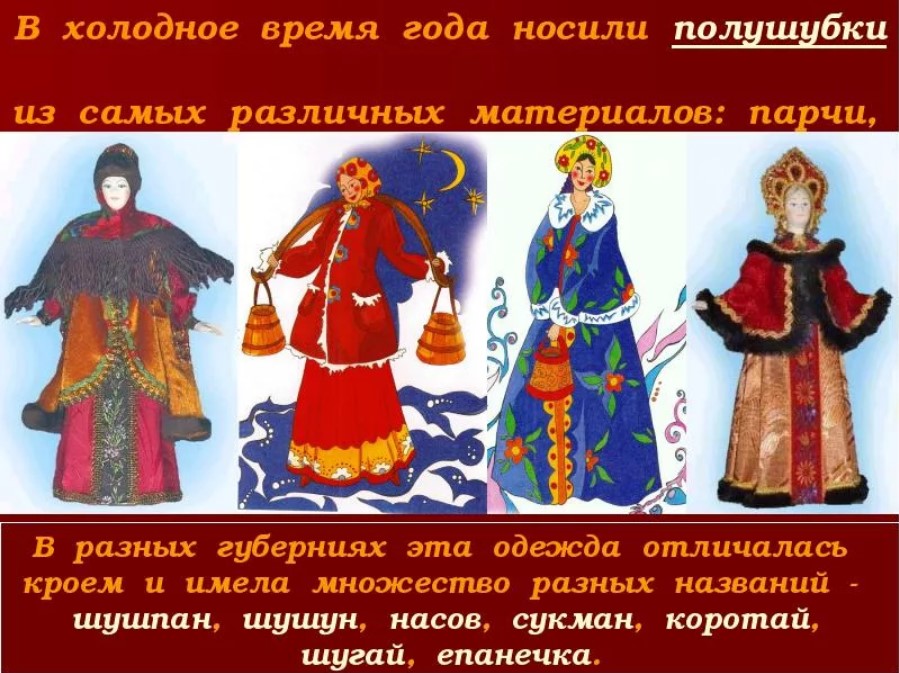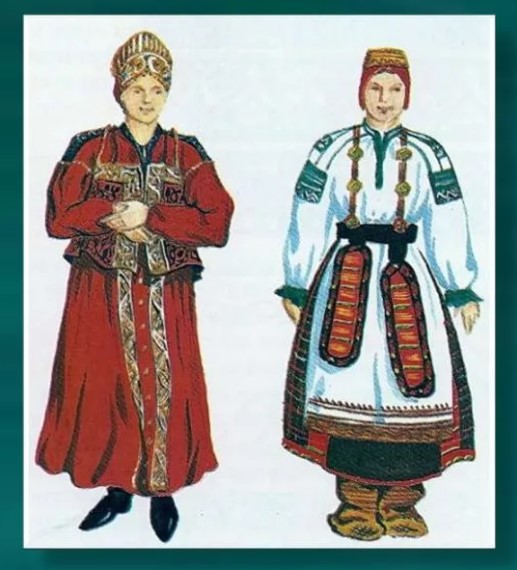 Today in Sweden and Germany there is a custom of wearing national clothes even on holidays that have nothing to do with the customs of their ancestors. In our fast paced life, such days, filled with joy and respect, give a person a feeling of security and belonging to age-old traditions.
Today in Sweden and Germany there is a custom of wearing national clothes even on holidays that have nothing to do with the customs of their ancestors. In our fast paced life, such days, filled with joy and respect, give a person a feeling of security and belonging to age-old traditions.
Russia has a very rich history of Russian national costume; there are families that still have their grandmother’s embroidery. In old great-grandmother's photographs, clothes still bear the imprint of the tradition of their ancestors.
Russian national costume
The national costume of any country reflects the natural conditions of the area, the attitude towards family values and the main types of employment of people. Let's look at what women's and men's clothing consisted of, and their names with detailed descriptions and photos.

Important! The Russian national costume differed by area of residence, marital status, there were sets for everyday wear and festive clothing.
There are two types of national set of Rus':
- northern regions;
- southern
In the central part of Russia they wore clothes similar to the northern costume. At that time, there were layers of clothing, many types of outerwear.
History of Russian national costume
In the form we know, the national costume was formed in Ancient Rus' around the seventh century. Over the following centuries it changed little.
The Russians' main activity was agriculture; many holidays and customs are associated with the wheat harvest. Clothing also reflected the main occupation of the peasants. The cut and the custom of tying up were aimed at making the suit comfortable for working in the field.

Interesting! Before the reign of Peter I, the national costume in Russia was worn by all classes, only the nobility used expensive materials and more decorations. In 1699, by decree of Peter I, the wearing of national costume was prohibited; an exception was made for the peasant class; village residents were allowed to continue wearing their usual clothes. A duty was introduced on beards and Russian costumes for everyone entering the city.
Elements of Russian folk costume
According to their purpose, clothing was divided into casual, work and festive. Festive clothes were richly decorated, everyday clothes also had embroidery, work clothes were the simplest, made from durable materials.
Reference! The harvest shirt was decorated with embroidery in the same way as the holiday one, this expressed the attitude of the peasants to the harvest.

All outerwear of the Russian national costume there were two types:
- loose clothing, fastened in front with buttons or hooks;
- cap, dressed over the head.
What does a woman's suit consist of?
Women's national costume is much more beautiful and interesting than men's.
The main parts of the kits came from Ancient Rus'.Women's national costume embodies the ideas of that time about female beauty and family values.

The silhouette is straight or widened down; it was not customary to emphasize the figure; the national set is characterized by multi-layering.
Women's suits are distinguished by purpose:
- everyday clothing was made of cotton, linen and woolen fabric and included up to seven items;
- Velvet, brocade, and good quality wool were used in tailoring elegant clothes. A festive women's clothing set could consist of twenty items. Such things were expensive, carefully decorated, and worn on special holidays and to church. Elegant sets were kept in chests, and the best was passed on by inheritance.

Sundress set
The basis of the Northern Russian costume was the shirt; it was sewn from linen and cotton fabric. The bottom of the shirt, sleeves and neck were decorated with embroidery. Embroidery was more modest for an everyday shirt, while a festive shirt was richly decorated with embroidered motifs.
A sundress was worn over the shirt. The sundress is one of the characteristic details of the Russian national costume. Translated from Iranian it means “fully dressed.” Over the sundress they wore a beautiful belt and apron. In Rus' they wore an open sundress with embroidery along the edge of the hem and a button closure.

"Round" sundress did not have a fastener, otherwise it was called “straight” and it appeared much later than the swing one.
On top of the sundress in the festive costume of a peasant woman, an elegant soul warmer was dressed. At the top it was gathered into small folds, and at the bottom it was wide. The length barely covered the waist. Such a warmer was made from expensive fabrics, brocade and velvet.

The winter sundress was made of cloth; a warm soul warmer, shubey, opashin or quilted warmer was worn on top.The warm soul warmer was quilted with cotton wool and decorated with fur trim. The outfit was completed with warm woolen stockings, a shawl and a warm headdress.

Powder kit
The pony kit is considered older, wore it in the southern regions of Russia.
This set consists of a long canvas shirt and a blanket.

Festive outfit and for every day
Poneva is a skirt. There are blind and swing poneva. It consisted of three panels and was richly decorated with woven patterns and embroidery. The basis was checkered woolen fabric; the hem and panel were decorated with rows of embroidery or braid. A narrow belt, a gasket, was held at the waist.
In the villages there was a custom of “putting on a poneva”, which meant that the girl could now be matched.
Women's hats
The headdress not only protected the head, but could also tell a lot about the woman.

Headdress of an unmarried girl consisted of ribbons and braid. The hair was partially exposed to view.

After marriage, the woman put on a kika, an ubrus scarf, and her hair was completely covered.
On holidays, married women wore an elegant headdress - kokoshnik. Kika and kokoshnik were intended for going out in public; at home, a woman wore a warrior (cap) and a scarf.

Russian kokoshnik
Complemented the outfit chest and neck decorations. Such jewelry consisted of beads, colored wool and beaded threads.
In elegant women's clothing, even the buttons were richly decorated.
Men's national costume
Unlike the women's suit, the men's suit was less colorful and consisted of fewer items. In a men's suit, it was customary to emphasize the figure, and consisted of the following elements.
Shirt
All men, starting with boys, wore shirts, mostly shirts.
Reference! It is believed that at first the shirt fastener was in the center, and the shirt appeared so that the pectoral cross would not fall out during work.
Neck, sleeves and hem decorated with embroidered motifs, the embroidery on the shirt in which they got married had to be done by the bride. This custom has a sacred meaning, such embroidery, made by the hands of a loving woman, served as a talisman.

A caftan was worn over the shirt. Men could wear a long caftan or a short caftan. The caftan was fastened with buttons or tied with ribbons.
Pants and belt
Men's trousers or ports were made of striped fabric. More often they are of small volume; wide trousers are less common. The length of the ports is shortened, as it was customary to tuck the bottom of the pants into the top of the boots. Later, pockets appeared, and at first everything needed was tied to the belt.

All peasants tied themselves with an embroidered belt, wide and long, unmarried guys. Married men tied themselves with a narrow and short belt.
The belt was tied differently on the figure: young men emphasized their waist with a belt; the old people had a belt under their stomachs.
Headdress
Men always complemented the suit with a headdress. At first it was a woolen sinner cap, later a cap appeared, a special type of cap, decorated with ribbons, flowers, and beads. In winter they protected their heads with a hat with earflaps.

There were other winter hats that came from Ancient Rus'. A small tafya hat was worn under a winter hat. They protected their heads in cold weather by having murmurs widened towards the top. The hats were decorated with fur, which warmed the head well.
Outerwear
In autumn and winter cold, men wore sheepskin coats, fur coats, and retinues. The clothes of wealthy peasants were decorated with a fur collar; in the outer clothing of the poor, a standing collar protected them from the cold wind.

Traditional clothing of the 17th century. in Rus'
Everyone wore fur coats: the poor had fur coats made of hare or sheepskin, the rich wore fur coats made of sable or marten. To make it warmer, the fur coat was worn with the fur inside, and the top was covered with cloth.
Russian national costume has a very rich history. Individual items today serve as a source of inspiration for fashion designers. The abundance of types of clothing and the variety of embroidery motifs provide good ground for successors who create modern clothing.


 2
2





